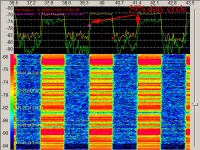Signal Identification
From HFUnderground
(→Basic information shown for all Entries) |
|||
| (30 intermediate revisions not shown) | |||
| Line 1: | Line 1: | ||
| - | '''Still under | + | '''Still under construction, call this a late Beta version, almost ready for prime time''' |
| - | + | ||
| + | See also: [[Emission_Designator|emission designators page]] | ||
---- | ---- | ||
| Line 41: | Line 41: | ||
'''DATA Signals:''' | '''DATA Signals:''' | ||
| - | DATA Signals are pretty much everything else. If it goes through a modem or is computer generated before being transmitted to the open air it will probably be included in the DATA Signals section. This includes digital voice modes, including many encrypted modes. The DATA Signals section is loosely broken down into the type of modulation used for the data, FSK, MFSK, PSK, etc. | + | DATA Signals are pretty much everything else. If it goes through a modem or is computer generated before being transmitted to the open air it will probably be included in the DATA Signals section. This includes [[Telemetry|telemetry]] modes, [[HF_pagers|pager/paging systems]] such as [[POCSAG]] and [[FLEX]], and digital voice modes, including many encrypted modes. The DATA Signals section is loosely broken down into the type of modulation used for the data, FSK, MFSK, PSK, etc. |
| - | Various image modes, such as HFFAX, SSTV, etc, are included in the DATA Signals, even when they are not digital in nature. Despite many of these types having analogue backgrounds most are generated by computer today. | + | Various image modes, such as HFFAX, [[SSTV]], etc, are included in the DATA Signals, even when they are not digital in nature. Despite many of these types having analogue backgrounds most are generated by computer today. |
| Line 62: | Line 62: | ||
=== Mode === | === Mode === | ||
| - | "Mode" is simply a generally accepted name of the technique. This may not be the only designator used for that specific technique. For example, traditional "AM" can also be described as "Double sideband with full carrier", and "A3E". In such a case these other designations may be included on the Mode Specific page. If a Mode Specific page exist for a mode you can access it by clicking on the name in the Mode column. The Mode Specific page will generally contain more detailed information than can be included in this initial chart. | + | "Mode" is simply a generally accepted name of the technique. This may not be the only [[Emission_Designator|designator]] used for that specific technique. For example, traditional "AM" can also be described as "Double sideband with full carrier", and "A3E". In such a case these other designations may be included on the Mode Specific page. If a Mode Specific page exist for a mode you can access it by clicking on the name in the Mode column. The Mode Specific page will generally contain more detailed information than can be included in this initial chart. |
=== Frequency Range (kHz) === | === Frequency Range (kHz) === | ||
| Line 86: | Line 86: | ||
=== Spectrum Image === | === Spectrum Image === | ||
| - | "Spectrum Image" is a 200 pixel wide expandable thumbnail image of the signal, | + | "Spectrum Image" is a 200 pixel wide expandable thumbnail image of the signal, often either the spectrum or a waterfall / histogram of some kind. Typically the full size version of this images is at least 640 x 480. |
| - | + | ||
| - | + | ||
| - | + | ||
=The Signals= | =The Signals= | ||
| Line 172: | Line 169: | ||
| Not Applicable | | Not Applicable | ||
| FMCW transmission, changes sweep rates in 16 steps, resulting in 16 different sounds per transmission, a pilot tone may precede each rate change but is not always present | | FMCW transmission, changes sweep rates in 16 steps, resulting in 16 different sounds per transmission, a pilot tone may precede each rate change but is not always present | ||
| - | | | + | | Jindalee Operational Radar Network (JORN) |
| [[Media:16x64_sounder.mp3]] | | [[Media:16x64_sounder.mp3]] | ||
16 x 64 sounder recording | 16 x 64 sounder recording | ||
| [[File:16x64_sounder.jpg|200px]] | | [[File:16x64_sounder.jpg|200px]] | ||
|- | |- | ||
| - | | PLUTO radar (possible offical name, PLUTO II, suggested by | + | | 29B6 radar "Kontainer" |
| + | | 6000 to 20000 | ||
| + | | 4 to 28 kHz observed, unknown limits, width depending on specific operating conditions | ||
| + | | Not Applicable | ||
| + | | Not Applicable | ||
| + | | FMOP transmission, presenting a wide signal equal to the swept (chirped) width, sweep rate creates a pulsed sound affect, easily confused with British PLUTO radar | ||
| + | | Kovylkino, Mordovia, Russia | ||
| + | | [[Media:29B6.mp3]] | ||
| + | 29B6 recording, first portion wide audio, second narrow, as would be heard on many receivers | ||
| + | | [[File:29B6.jpg|200px]] | ||
| + | |- | ||
| + | | CODAR (Coastal Ocean Dynamics Applications Radar), a specialized radar used to study ocena currents and waves | ||
| + | | 4000 to 27000 | ||
| + | | 16 to 240 kHz, depending on band, higher frequencies mean wider swept widths | ||
| + | | Not Applicable | ||
| + | | Not Applicable | ||
| + | | FMOP or FMICW transmission, presenting a wide signal equal to the swept (chirped) width, sweep rate can create "swooshing" sounds on radio, pulsed transmission can give the sound a rough quality | ||
| + | | World wide, hundreds of locations around the World | ||
| + | | [[Media:CODAR.mp3]] | ||
| + | CODAR recording, first 40 seconds in USB, next 40 in AM, last 40 in LSB | ||
| + | | [[File:CODAR_sweeps.jpg|200px]] | ||
| + | [[File:CODAR_pulses.jpg|200px]] | ||
| + | |- | ||
| + | | PLUTO radar (possible offical name, PLUTO II, suggested by online documents) | ||
| 8000 to 38000 | | 8000 to 38000 | ||
| 3 to 40 kHz, depending on specific operating conditions | | 3 to 40 kHz, depending on specific operating conditions | ||
| Not Applicable | | Not Applicable | ||
| Not Applicable | | Not Applicable | ||
| - | | FMCW transmission, presenting a wide signal equal to the swept (chirped) width, sweep rate creates a pulsed sound affect | + | | FMCW transmission, presenting a wide signal equal to the swept (chirped) width, sweep rate creates a pulsed sound affect, easily confused with Russian 29B6 radar |
| British Sovereing base of Akrotiri, Island of Cyprus | | British Sovereing base of Akrotiri, Island of Cyprus | ||
| [[Media:PLUTO_50Hz.mp3]] | | [[Media:PLUTO_50Hz.mp3]] | ||
| Line 190: | Line 210: | ||
|- | |- | ||
|} | |} | ||
| - | |||
| - | |||
| - | |||
| - | |||
==DATA Signals== | ==DATA Signals== | ||
| Line 215: | Line 231: | ||
| 85, 125, 250, or 500, only one shift used at a time | | 85, 125, 250, or 500, only one shift used at a time | ||
| 2 | | 2 | ||
| - | | Appears as two lines on waterfall, seperated by the shift, normally encrypted | + | | Appears as two lines on waterfall, seperated by the shift, normally encrypted, at idle presents 36 Bd |
| - | | Used by Russian | + | | Used primarily by Russian Navy, a mode of the T-600 modem |
| [[Media:CIS_36_50.mp3]] | | [[Media:CIS_36_50.mp3]] | ||
CIS 36-50 recording | CIS 36-50 recording | ||
| Line 226: | Line 242: | ||
| 200 or 250 Hz, only one shift used at a time | | 200 or 250 Hz, only one shift used at a time | ||
| 2 | | 2 | ||
| - | | Appears as two lines on waterfall, seperated by the shift, normally encrypted | + | | Appears as two lines on waterfall, seperated by the shift, normally encrypted, at idle presents 50 Bd |
| - | | Used by Russian | + | | Used primarily by Russian Navy, a mode of the T-600 modem |
| [[Media:CIS_50_50.mp3]] | | [[Media:CIS_50_50.mp3]] | ||
CIS 50-50 recording | CIS 50-50 recording | ||
| [[File:CIS_50_50.jpg|200px]] | | [[File:CIS_50_50.jpg|200px]] | ||
|- | |- | ||
| - | | STANAG 4481 FSK | + | | [[STANAG]] [[4481 FSK]] |
| All Frequencies in the HF Range | | All Frequencies in the HF Range | ||
| 0.85 kHz (850 Hz) | | 0.85 kHz (850 Hz) | ||
| Line 269: | Line 285: | ||
| [[File:ALE_snd.jpg|200px]] | | [[File:ALE_snd.jpg|200px]] | ||
|- | |- | ||
| + | | JT-65 [[JT65]] | ||
| + | | All ham bands | ||
| + | | 0.175 kHz (175 Hz) | ||
| + | | ~2.65 Hz | ||
| + | | 65 | ||
| + | | Appears as stepped lines on the waterfall, has a musical sound to it, can be confused by new listeners for a polytone numbers station like XPA | ||
| + | | Used world wide | ||
| + | | [[Media:JT65.mp3]] | ||
| + | JT65 recording | ||
| + | | [[File:JT65.jpg|200px]] | ||
| + | |- | ||
| + | |||
|} | |} | ||
| Line 283: | Line 311: | ||
! Recording | ! Recording | ||
! Spectrum Image | ! Spectrum Image | ||
| + | |- | ||
| + | | (Chinese) CHN 4+4 | ||
| + | | All Frequencies in the HF Range | ||
| + | | 2.9 kHz | ||
| + | | 300 Hz, with 450 Hz gap | ||
| + | | 8 | ||
| + | | Appears as 8 PSK tones on the waterfall, noticeable 450 Hz gap between tones 4 and 5 | ||
| + | | Used by Chinese military | ||
| + | | [[Media:CHN4_4.mp3]] | ||
| + | CHN 4+4 recording | ||
| + | | [[File:CHN4_4.jpg|200px]] | ||
| + | |- | ||
| + | | CIS12, Fire, MS5, AT3004D, AT3104D | ||
| + | | All Frequencies in the HF Range | ||
| + | | 3.3 kHz | ||
| + | | 200 Hz (12 tone) or 120 Hz (20 tone) | ||
| + | | 12 or 20 | ||
| + | | Appears as 12 or 20 PSK tones on the waterfall, with 3300 Hz Doppler (pilot) tone | ||
| + | | Used primarily by Russian military | ||
| + | | [[Media:CIS12.mp3]] | ||
| + | CIS12 recording | ||
| + | | [[File:CIS12.jpg|200px]] | ||
| + | |- | ||
| + | | [[PSK31]] | ||
| + | | Mostly in the ham radio bands | ||
| + | | | ||
| + | | | ||
| + | | | ||
| + | | | ||
| + | | Used world wide | ||
| + | | [[Media:psk31_recording.mp3]] | ||
| + | | | ||
| + | |- | ||
|} | |} | ||
| Line 311: | Line 372: | ||
! Recording | ! Recording | ||
! Spectrum Image | ! Spectrum Image | ||
| + | |- | ||
| + | | Slow Scan TV [[SSTV]] | ||
| + | | Mostly in the ham radio bands | ||
| + | | 1100-2300 Hz | ||
| + | | | ||
| + | | | ||
| + | | Distinctive burst of VIS code bits at the beginning, then a rhythmic sound as the scan lines of video are sent | ||
| + | | Used world wide | ||
| + | | [[Media:Robot36C.WAV]] | ||
| + | | [[File:Sstv_waterfall.png|200px]] | ||
| + | |- | ||
| + | | Weather Fascimile [[Fax]] | ||
| + | | All Frequencies in the HF Range | ||
| + | | 1500-2300 Hz | ||
| + | | | ||
| + | | | ||
| + | | Rhythmic sound as the scan lines of video are sent twice a second | ||
| + | | Used world wide | ||
| + | | [[Media:Fax_signal.mp3]] | ||
| + | | [[File:fax_waterfall.png|200px]] | ||
| + | |- | ||
| + | | Hellschreiber [[Hellschreiber]] | ||
| + | | Mostly in the ham radio bands | ||
| + | | | ||
| + | | | ||
| + | | | ||
| + | | Scratchy sound as the pixels of each character are sent | ||
| + | | Used world wide | ||
| + | | | ||
| + | | | ||
| + | |- | ||
|} | |} | ||
| Line 334: | Line 426: | ||
| Not Applicable | | Not Applicable | ||
| Various shapes, but typically presents as a sweeping, unstable, signal on a waterfall | | Various shapes, but typically presents as a sweeping, unstable, signal on a waterfall | ||
| - | | Unknown | + | | Unknown, a strong theory is these are related to industrial processes, possibly RF Welding |
| - | | Sweeper recording | + | | [[Media:UNID001_Sweepers.mp3]] |
| - | | [[File: | + | Sweeper recording, multple examples |
| + | | [[File:UNID001_Sweepers.jpg|200px]] | ||
|- | |- | ||
| HFU UNID002 | | HFU UNID002 | ||
| Line 344: | Line 437: | ||
| Not Applicable | | Not Applicable | ||
| Not Applicable | | Not Applicable | ||
| - | | Appears as a periodic dit or dash on a waterfall with fixed spacing between Pips, typical lengths are 0.063 | + | | Appears as a periodic dit or dash on a waterfall with fixed spacing between Pips, typical lengths are 0.063 to 1.5 sec, spacing has ranged from 3.0 to 27 seconds |
| Unknown | | Unknown | ||
| - | | Pips recording | + | | [[Media:UNID002_Pips.mp3]] |
| - | | [[File: | + | Pips recording, multiple examples |
| + | | [[File:UNID002_Pips.jpg|200px]] | ||
|- | |- | ||
|} | |} | ||
| Line 354: | Line 448: | ||
---- | ---- | ||
| + | |||
| + | |||
| + | |||
| + | [[Category: Transmission modes]] | ||
Latest revision as of 00:09, 5 August 2024
Still under construction, call this a late Beta version, almost ready for prime time
See also: emission designators page
Contents |
Why is this Guide here?
The goal of this Wiki is to help people ID sounds and signals they might come across on the radio, primarily in the HF (3000 to 30000 kHz) and MW (300 to 3000 kHz) bands. Of course not all possible signals can be identified, and certainly they cannot all be presented here. So the IDs will start with the most common modes and move forward from those. As signals to be IDed are presented and hopefully identified on the HFUnderground HF Mystery Signals board they will be added to these lists, assuming they were not already here.
With the advent and proliferation of SDRs to the hobby of shortwave listening, and the often associated wideband waterfall / spectrum displays, hobbyist are now more likely to notice short duration, transient, signals. Signals are now visually presented that in the past would not have been noticed at all unless the listener just happened to be tuned to the right random frequency when the short duration signal occurred. This has had the affect of raising the probability of reception of any given signal type, regardless of duration. Further, these waterfalls and spectrum images can be used to help ID specific modes of operation, as different techniques often have very different visual signatures.
Today's online receiver nodes (from services like Globaltuners, SDR-Radio.com, and WebSDR.org) mean that more people than ever potentially have access to monitor the HF spectrum. Often people with no prior exposure to HF radio or shortwave listening first gravitate to these kinds of services, as they take no investment in equipment to start using. They then face a sometimes steep learning curve of "what am I hearing, and what are these things on the radio".
In general the use of analogue voice and manual communications modes on the HF and MW bands is on the decline, replaced with digital and data modes. The use of other than communications modes, such as ionospheric sounders and HF radars, seems to be at an all-time high. For the new listener, or for more experienced listeners without the proper tools, identifying some of these modes and signals can be a challenge.
How to submit a signal for ID?
Go to the HFUnderground HF Mystery Signals board and follow the guidelines presented there for posting. Assuming the signal is IDed there, and it is not already on the list here, it will likely be added to this list.
How to use this Identification Guide?
If you look at the tables of the guide you will see it is divided into three types of signals, "Non DATA Signals", "DATA Signals", and "Unidentified Signals". Each section can be further broken down into sub categories.
Non DATA Signals:
Non DATA Signals are modes that do not carry what is traditionally thought of as digital data. This will be analogue voice modes, traditional Morse Code transmissions, and signals along those basic lines. Radars and Ionosondes have also been included in this segment, as they are not typically DATA transmissions.
DATA Signals:
DATA Signals are pretty much everything else. If it goes through a modem or is computer generated before being transmitted to the open air it will probably be included in the DATA Signals section. This includes telemetry modes, pager/paging systems such as POCSAG and FLEX, and digital voice modes, including many encrypted modes. The DATA Signals section is loosely broken down into the type of modulation used for the data, FSK, MFSK, PSK, etc.
Various image modes, such as HFFAX, SSTV, etc, are included in the DATA Signals, even when they are not digital in nature. Despite many of these types having analogue backgrounds most are generated by computer today.
Unidentified Signals:
Unidentified Signals are signals that have not yet been identified. As they are reported or added they will be assigned an "HFU UNID" sequential 3 digit number. This number means nothing, and is just a way to track information and discussions about that signal on the HFUnderground HF Mystery Signals board.
These UNID signals may appear in more than one segment of the guide, they will be in the Unidentified Signals segment, but may also be shown under their modulation types. For example, an Unknown signal that is obviously an FSK signal may be in both the Unidentified Signals area, and the FSK area, but in both cases they will carry the same UNID number.
Basic information shown for all Entries
Mode
"Mode" is simply a generally accepted name of the technique. This may not be the only designator used for that specific technique. For example, traditional "AM" can also be described as "Double sideband with full carrier", and "A3E". In such a case these other designations may be included on the Mode Specific page. If a Mode Specific page exist for a mode you can access it by clicking on the name in the Mode column. The Mode Specific page will generally contain more detailed information than can be included in this initial chart.
Frequency Range (kHz)
"Frequency Range (kHz)" is the range of frequencies where one might find this specific mode in use. For many modes this can be a very wide range, but other modes might be very limited in range. Remember this guide is MW and HF specific and may not consider usage in other frequency ranges.
Bandwidth (kHz)
"Bandwidth (kHz)" is the normally occupied bandwidth of the signal, as might be seen on a waterfall or spectrum display. Unless you include the power point for the measurement (3 dB, 6 dB, 10 dB, 20 dB, etc) this is an approximate value only. Because of this very strong signals can appear wider than very weak signals, even if both signals are actually using the same bandwidth. The goal here is to provide something that might help identification, not to define a technical specification for the mode.
Shift (kHz)
"Shift (kHz)" is something that only applies to certain types of DATA or digital transmissions. It will be used to define the spacing for visually definable tones or data channels in a transmission.
Number of Tones
"Number of Tones" is applicable to certain types of DATA or digital transmissions. It will be used to indicate the number of visually definable tones or data channels in a transmission.
Key Features
"Key Features" will be selected features that can help identify the signal, or at least narrow down the candidate pool. Ideally it will be one or two visually distinctive features that can be seen on a waterfall or spectrum display, but these might also be auditory features.
Sources
"Sources" are the most likely source for this transmission mode, if known.
Recording
"Recording" will link to an audio recording of the mode. Further recordings, both audio and video, may be present on the Mode Specific page.
Spectrum Image
"Spectrum Image" is a 200 pixel wide expandable thumbnail image of the signal, often either the spectrum or a waterfall / histogram of some kind. Typically the full size version of this images is at least 640 x 480.
The Signals
Non DATA Signals
Communications Modes
| Mode | Frequency Range (kHz) | Bandwidth (kHz) | Shift (Hz) | Number of Tones | Key Features | Sources | Recording | Spectrum Image |
|---|---|---|---|---|---|---|---|---|
| AM | All Frequencies in the HF Range | Typically 2.6 to 10.0 kHz, can be wider or narrower | Not Applicable | Not Applicable | Carrier present in center of signal, audio typically mirrored left and right of the carrier | World wide | AM recording link here | 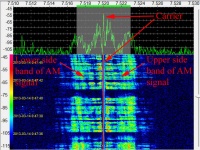
|
| CW
(Morse Code) | All Frequencies in the HF Range | Very narrow, potentially less than 50 Hz | Not Applicable | Not Applicable | Line or broken line on the waterfall, no sidebands, may show wider "key clicks" at the start and stop of each dot and dash | World wide | CW recording link here | 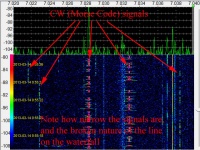
|
| LSB | All Frequencies in the HF Range | Typically 2.4 to 3.0 kHz, can be wider or narrower | Not Applicable | Not Applicable | No carrier present in Spectrum, audio typically bunched to towards the right (low audio frequency) | World wide | LSB recording link here | 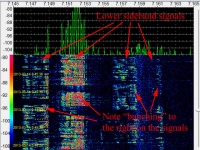
|
| USB | All Frequencies in the HF Range | Typically 2.4 to 3.0 kHz, can be wider or narrower | Not Applicable | Not Applicable | No carrier present in Spectrum, audio typically bunched to towards the left (low audio frequency) | World wide | USB recording link here | 
|
Non Communications Modes
| Mode | Frequency Range (kHz) | Bandwidth (kHz) | Shift (Hz) | Number of Tones | Key Features | Sources | Recording | Spectrum Image |
|---|---|---|---|---|---|---|---|---|
| 16 x 64 Sounder (nickname, official name or designation not known) | Below 4000 to above 30000 observed | 2.5 kHz | Not Applicable | Not Applicable | FMCW transmission, changes sweep rates in 16 steps, resulting in 16 different sounds per transmission, a pilot tone may precede each rate change but is not always present | Jindalee Operational Radar Network (JORN) | Media:16x64_sounder.mp3
16 x 64 sounder recording | 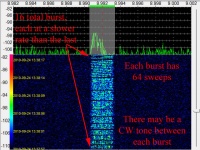
|
| 29B6 radar "Kontainer" | 6000 to 20000 | 4 to 28 kHz observed, unknown limits, width depending on specific operating conditions | Not Applicable | Not Applicable | FMOP transmission, presenting a wide signal equal to the swept (chirped) width, sweep rate creates a pulsed sound affect, easily confused with British PLUTO radar | Kovylkino, Mordovia, Russia | Media:29B6.mp3
29B6 recording, first portion wide audio, second narrow, as would be heard on many receivers | 
|
| CODAR (Coastal Ocean Dynamics Applications Radar), a specialized radar used to study ocena currents and waves | 4000 to 27000 | 16 to 240 kHz, depending on band, higher frequencies mean wider swept widths | Not Applicable | Not Applicable | FMOP or FMICW transmission, presenting a wide signal equal to the swept (chirped) width, sweep rate can create "swooshing" sounds on radio, pulsed transmission can give the sound a rough quality | World wide, hundreds of locations around the World | Media:CODAR.mp3
CODAR recording, first 40 seconds in USB, next 40 in AM, last 40 in LSB | 
|
| PLUTO radar (possible offical name, PLUTO II, suggested by online documents) | 8000 to 38000 | 3 to 40 kHz, depending on specific operating conditions | Not Applicable | Not Applicable | FMCW transmission, presenting a wide signal equal to the swept (chirped) width, sweep rate creates a pulsed sound affect, easily confused with Russian 29B6 radar | British Sovereing base of Akrotiri, Island of Cyprus | Media:PLUTO_50Hz.mp3
Media:PLUTO_25Hz.mp3 PLUTO recording link here | 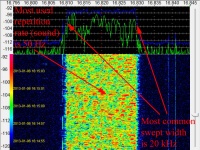
|
DATA Signals
FSK Modes
| Mode | Frequency Range (kHz) | Bandwidth (kHz) | Shift (Hz) | Number of Tones | Key Features | Sources | Recording | Spectrum Image |
|---|---|---|---|---|---|---|---|---|
| CIS 36-50, BEE, T-600 | All Frequencies in the HF Range | 0.085 to 0.500 kHz (85 to 500 Hz depending on mode) | 85, 125, 250, or 500, only one shift used at a time | 2 | Appears as two lines on waterfall, seperated by the shift, normally encrypted, at idle presents 36 Bd | Used primarily by Russian Navy, a mode of the T-600 modem | Media:CIS_36_50.mp3
CIS 36-50 recording | 200px |
| CIS 50-50, BEE, T-600 | All Frequencies in the HF Range | 0.200 to 0.250 kHz (200 or 250 Hz depending on mode) | 200 or 250 Hz, only one shift used at a time | 2 | Appears as two lines on waterfall, seperated by the shift, normally encrypted, at idle presents 50 Bd | Used primarily by Russian Navy, a mode of the T-600 modem | Media:CIS_50_50.mp3
CIS 50-50 recording | 
|
| STANAG 4481 FSK | All Frequencies in the HF Range | 0.85 kHz (850 Hz) | 850 Hz | 2 | Appears as two lines on waterfall, seperated by the shift, normally encrypted | Used by NATO forces world wide | Media:S4481_FSK.mp3
4481 FSK recording | 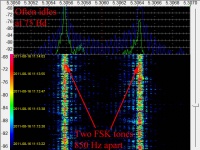
|
MFSK Modes
| Mode | Frequency Range (kHz) | Bandwidth (kHz) | Shift (Hz) | Number of Tones | Key Features | Sources | Recording | Spectrum Image |
|---|---|---|---|---|---|---|---|---|
| MIL STD 181-141A ALE | All Frequencies in the HF Range | 1.75 kHz (1750 Hz) | 250 Hz | 8 | Appears as eight broken lines on waterfall, seperated by the shift, normally encrypted, rhythmic sound | Used world wide | Media:ALE_SND.mp3
MIL STD 188-141A sounding recording | 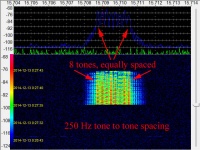
|
| JT-65 JT65 | All ham bands | 0.175 kHz (175 Hz) | ~2.65 Hz | 65 | Appears as stepped lines on the waterfall, has a musical sound to it, can be confused by new listeners for a polytone numbers station like XPA | Used world wide | Media:JT65.mp3
JT65 recording | 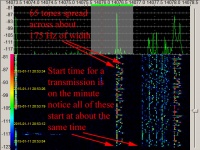
|
PSK Modes
| Mode | Frequency Range (kHz) | Bandwidth (kHz) | Shift (Hz) | Number of Tones | Key Features | Sources | Recording | Spectrum Image |
|---|---|---|---|---|---|---|---|---|
| (Chinese) CHN 4+4 | All Frequencies in the HF Range | 2.9 kHz | 300 Hz, with 450 Hz gap | 8 | Appears as 8 PSK tones on the waterfall, noticeable 450 Hz gap between tones 4 and 5 | Used by Chinese military | Media:CHN4_4.mp3
CHN 4+4 recording | 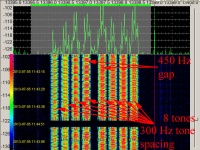
|
| CIS12, Fire, MS5, AT3004D, AT3104D | All Frequencies in the HF Range | 3.3 kHz | 200 Hz (12 tone) or 120 Hz (20 tone) | 12 or 20 | Appears as 12 or 20 PSK tones on the waterfall, with 3300 Hz Doppler (pilot) tone | Used primarily by Russian military | Media:CIS12.mp3
CIS12 recording | 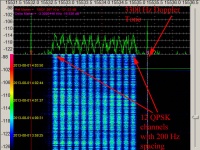
|
| PSK31 | Mostly in the ham radio bands | Used world wide | Media:psk31_recording.mp3 |
SELCAL Modes
| Mode | Frequency Range (kHz) | Bandwidth (kHz) | Shift (Hz) | Number of Tones | Key Features | Sources | Recording | Spectrum Image |
|---|
Image Modes
| Mode | Frequency Range (kHz) | Bandwidth (kHz) | Shift (Hz) | Number of Tones | Key Features | Sources | Recording | Spectrum Image |
|---|---|---|---|---|---|---|---|---|
| Slow Scan TV SSTV | Mostly in the ham radio bands | 1100-2300 Hz | Distinctive burst of VIS code bits at the beginning, then a rhythmic sound as the scan lines of video are sent | Used world wide | Media:Robot36C.WAV | 
| ||
| Weather Fascimile Fax | All Frequencies in the HF Range | 1500-2300 Hz | Rhythmic sound as the scan lines of video are sent twice a second | Used world wide | Media:Fax_signal.mp3 | 
| ||
| Hellschreiber Hellschreiber | Mostly in the ham radio bands | Scratchy sound as the pixels of each character are sent | Used world wide |
Unidentified Signals
| Mode | Frequency Range (kHz) | Bandwidth (kHz) | Shift (Hz) | Number of Tones | Key Features | Sources | Recording | Spectrum Image |
|---|---|---|---|---|---|---|---|---|
| HFU UNID001
Sweepers | All Frequencies in the HF Range, but primarily noticed above 10000 kHz | Sub 2 kHz to over 200 kHz | Not Applicable | Not Applicable | Various shapes, but typically presents as a sweeping, unstable, signal on a waterfall | Unknown, a strong theory is these are related to industrial processes, possibly RF Welding | Media:UNID001_Sweepers.mp3
Sweeper recording, multple examples | 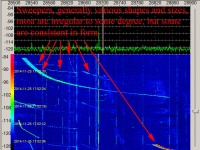
|
| HFU UNID002
Pips | All Frequencies in the HF Range | Typically very narrow, as CW, but occasionally with light 3 kHz modulation | Not Applicable | Not Applicable | Appears as a periodic dit or dash on a waterfall with fixed spacing between Pips, typical lengths are 0.063 to 1.5 sec, spacing has ranged from 3.0 to 27 seconds | Unknown | Media:UNID002_Pips.mp3
Pips recording, multiple examples | 
|
This site is a participant in the Amazon Services LLC Associates Program, an affiliate advertising program designed to provide a means for sites to earn advertising fees by advertising and linking to Amazon.com. Some links may be affiliate links. We may get paid if you buy something or take an action after clicking one of these.
